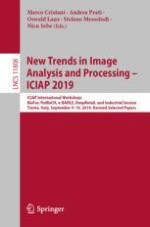2019 | Book
New Trends in Image Analysis and Processing – ICIAP 2019
ICIAP International Workshops, BioFor, PatReCH, e-BADLE, DeepRetail, and Industrial Session, Trento, Italy, September 9–10, 2019, Revised Selected Papers
Editors: Marco Cristani, Andrea Prati, Oswald Lanz, Stefano Messelodi, Nicu Sebe
Publisher: Springer International Publishing
Book Series : Lecture Notes in Computer Science
